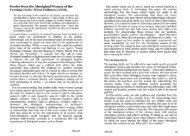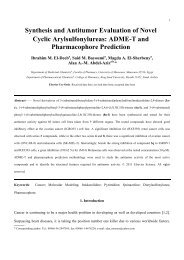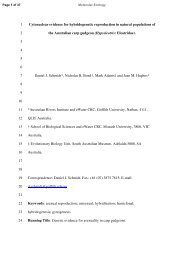Universal Primers for DNA barcoding of all Avian Species - Griffith ...
Universal Primers for DNA barcoding of all Avian Species - Griffith ...
Universal Primers for DNA barcoding of all Avian Species - Griffith ...
You also want an ePaper? Increase the reach of your titles
YUMPU automatically turns print PDFs into web optimized ePapers that Google loves.
190bp in size. Both primer sets were first tested on a range <strong>of</strong> modern samples with<br />
representative species from 15 different orders (Table 2) prior to be being used on historical<br />
specimens. Of a total <strong>of</strong> 29 species, both primer sets worked on <strong>all</strong> species tested.<br />
Twenty seven historical samples were utilized in this study belonging to nine different orders<br />
(See supporting in<strong>for</strong>mation Table S2 <strong>for</strong> species list). The age <strong>of</strong> the historical specimens<br />
tested ranged from 16 to 115 years. PCR products were amplified at similar success rates<br />
from both the three and five primer pair sets <strong>for</strong> the same given samples tested suggesting that<br />
the three primer pair set is the best option (Table 2). The AWCF1/AWCR6 primer pair which<br />
amplifies the entire 648bp COI fragment was used as a control <strong>for</strong> historical specimens with<br />
no products being amplified.<br />
Of the 27 historical samples tested, 16 samples successfully amplified the regions <strong>of</strong> interest<br />
resulting in an amplification success rate <strong>of</strong> 59%. Further analysis found PCR success to be<br />
strongly correlated with specimen age. When separated into age groups we found samples<br />
which were 80 years or less in age had a higher average amplification success rate <strong>of</strong> 77%<br />
(n=13) than their older counterparts <strong>of</strong> greater than 80 years <strong>of</strong> age which had an average<br />
amplification success rate <strong>of</strong> 50% (n=12). However there was no significance difference<br />
found between the two age groups (Fisher’s exact test, P value = 0.2262). Two <strong>of</strong> the 27<br />
samples were <strong>of</strong> unknown ages and could not be classified into age groups; neither produced<br />
positive PCR results.<br />
Historical specimens belonging to the orders Anseri<strong>for</strong>mes, Pelecani<strong>for</strong>mes and<br />
Psittaci<strong>for</strong>mes did not successfully amplify the three fragments or the five fragments.<br />
However, their modern representatives were successfully amplified suggesting that the<br />
problem was due <strong>DNA</strong> damage rather than issues with primer binding. Bar one, <strong>all</strong> samples<br />
were over 80 years <strong>of</strong> age, stressing again the importance <strong>of</strong> age on PCR success. For the<br />
orders Charadrii<strong>for</strong>mes and Anseri<strong>for</strong>mes the last primer pair (AWCintF5/AWCintR6) posed<br />
a problem <strong>for</strong> some species. We were able to design an alternate primer pair<br />
(AWCintF6/AWCintR7) <strong>for</strong> these orders (refer to Table 1). This primer pair could have<br />
future use <strong>for</strong> other untested orders if a similar problem is encountered.<br />
A number <strong>of</strong> previously described avian COI primers (Hebert et al. 2004; Kerr et al. 2009)<br />
designed to amplify a single fragment <strong>for</strong> modern samples from the Northern Hemisphere<br />
7





